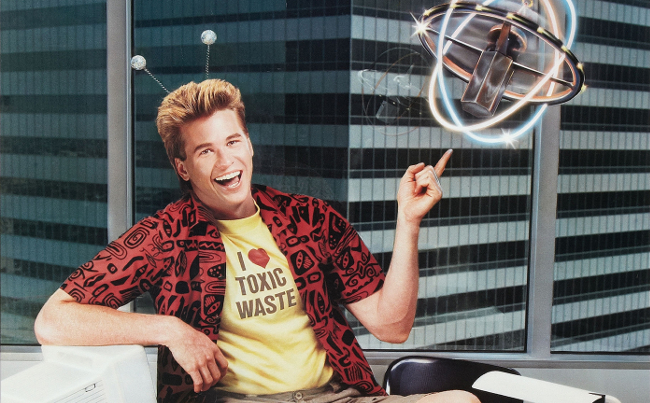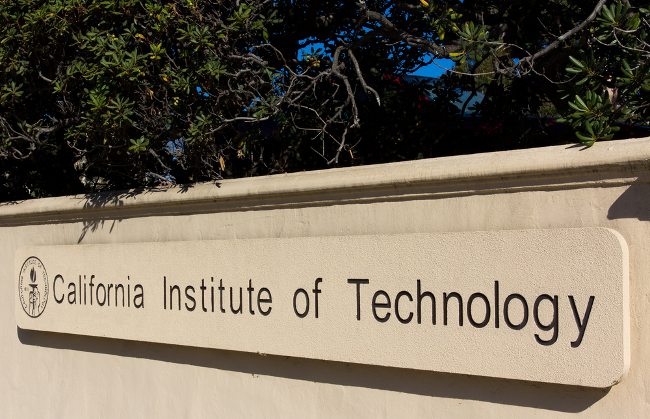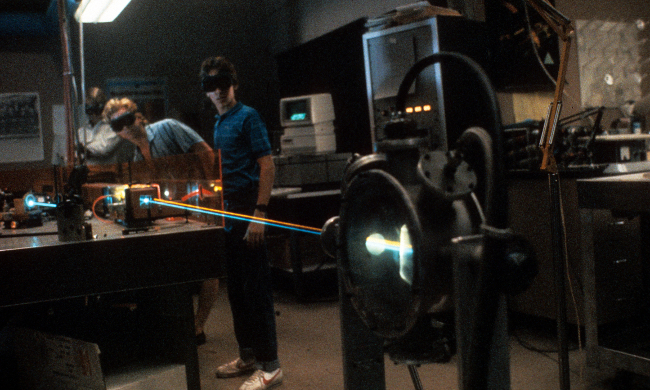
Long before Jennifer Lawrence and Shailene Woodley were leading the attractive Abercrombie youth against the big, bad old people in dystopian future societies, Hollywood’s young adults were saving America from itself in the Cold War. In WarGames, a brilliant teen hacker stopped a computer from launching all-out Global Thermonuclear War, while a group of high school bros and babes turned the tide during Russia’s invasion of the U.S. in Red Dawn. But in the 1985 comedy Real Genius, the young heroes resorted to a far more unusual strategy in stopping the evil government men: popcorn.
Specifically, Chris Knight (Val Kilmer) and his band of college geniuses decided that the best means of revenge against Professor Jerry Hathaway for using them to build a weapon was to use their own weapon to fill his house with popcorn. The story of how Real Genius, one of the more intelligent and accurate movies about college prodigies, came to be is as unique and clever as the film itself. Director Martha Coolidge originally passed on the opportunity to helm the film, because she wasn’t interested in making another typical ‘80s comedy. “I had been offered so many gross, boy-oriented teen comedies,” she tells us. “Nothing against it, but that’s all I was offered. When [Real Genius] first came to me, even though it was about smart people, it really wasn’t that smart yet. It was still in that same category. I was just skeptical and turned it down… twice actually.”
The original script was written by Neal Israel and Pat Proft, and Coolidge didn’t necessarily dislike what they had created. While it was very funny, she says, it “didn’t have a cohesive story” and was really just “an excuse to get into a school and have all these sex jokes,” and that’s why Pj Torokvei was brought in for a rewrite. Just as Lisa Gottlieb did with Just One of the Guys, which was released earlier that year, Coolidge wanted her film not only to mean something and have a good story, she wanted it to be realistic. It’s a film about a team of wiseass college geniuses who unknowingly build a death weapon for the government and use it to cook Jiffy Pop from an Air Force jet… How hard could it be?
Step 1: Do Your Research

First, in creating the fictional Pacific Tech, Coolidge and her cast and crew did a great deal of research on the student life at Caltech, because they wanted the film to deliver an accurate portrayal of young geniuses at work. The director interviewed students about their daily routines, study habits, classes, and social antics. She even hired a Caltech student to be her assistant. When it came to influencing the characters, Coolidge based Lazlo Hollyfeld (played by Jon Gries) on two legendary Caltech students. One lived in the school’s tunnels in order to avoid gym while the other discovered a loophole in contest rules to win a bunch of prizes.
And then there was the teen prodigy who inspired the role of Mitch Taylor, and almost played him. “I met a 14-year-old boy who was in his third year of undergrad at NYU,” Coolidge remembers. “He wanted to be an actor. He had already left school for a year to act on Broadway. He’s really who I based the character on. In the end he really wasn’t quite right for the part but he had a 180-something IQ. He speaks all over the world, and he graduated from NYU speedily and then went to law school. Finished law school in two years and then sued the Florida Bar in order to be able to practice law before he was 18.”
Enter: Gabriel Jarret, a 15-year-old actor with little experience but who embodied the character’s primary trait. “They knew that it wasn’t working with that person and they wanted someone who was, oh gosh, actually a nerd,” he tells us. “And I’m happy to say I got the part. I think. [Laughs.]”
What’s most interesting is that it wasn’t until after the film’s release that Coolidge learned that the one element not based on fact – students unwittingly being used by the government to create a weapon of mass destruction – was still pretty accurate. “I have had so many letters since I’ve made Real Genius from people who said, yes, I was involved in a program and I didn’t realize I was developing weapons,” she says. “So it was a good guess and turned out to be quite accurate.”
As for the film’s research into laser technology, Coolidge enlisted a professor who had taught at both Caltech and USC and was also “one of the leading laser scientists” in Ronald Reagan’s Star Wars program. Additionally, she picked the brain of a “long-time defense department black-money researcher,” who was responsible for the Navy’s psychic research.
“I’m still friends with Martin Gundersen, who was the professor of physics and electrical engineering at USC, and one of the authorities on lasers,” explains William Atherton, who plays Dr. Hathaway. “He was the technical liaison there, so he would explain the lasers, make sure that when we were in the science room, all of that was legit with a true scientific basis. So that whenever we talked about this or that, we always had reality with it, which is great because then you can riff on reality. You can’t riff on riff.”
Step 2: Establish The Idea

But even with all of her real government intel, Coolidge had one problem: She didn’t know what she wanted the laser to do in the final act of Real Genius. Fortunately, when Coolidge crowd-sourced her dilemma as a sort of “contest,” her friend Rob Cobb came calling with the perfect idea. A cartoonist and designer responsible for some of the creatures in the Star Wars Mos Eisley scene and the DeLorean time machine in Back to the Future, Cobb offered a simple, hilarious solution to Coolidge’s problem: “Establish that the guy hates popcorn, then blow his house up with popcorn.”
Coolidge and producer Brian Grazer loved the idea and it turned into their “million-dollar joke.” Being 1985, though, they didn’t have the visual effects capabilities to make it look like a house was overflowing with popcorn. That left Coolidge with one hell of a task.
“We didn’t have sophisticated visual effects then. We couldn’t do the popcorn,” Coolidge recalls. “So, the special effects guys had to learn everything there was to learn about popcorn, which they did. It was surprising. I remember it weighs two pounds per cubic foot – it’s more than you think. It’s either two pounds per cubic foot or one pound per cubic two-feet. But it was not like Styrofoam. Styrofoam would blow away, it’s too light. And so really, in the end after mucho debates, we realized we had to use real popcorn and that meant tons and tons and tons of popcorn.”
Step 3: Make 140 Tons of Popcorn
Even Professor Hathaway’s house had to be built from scratch by the film’s special effects team, because they couldn’t simply take the tons and tons and tons of popcorn, pump it into a real house, and get their expected results. This required significantly more effort, and the house became a large machine that funneled popcorn throughout, blowing out the windows and splitting the wood in the process. Because this scene couldn’t be done in one take, what was blown out and split apart had to come back together, and that required an intricate hydraulics system running inside the fake home.
“We had two elements,” she explains. “The interior, which we built on stage and that took about 40 tons of popcorn inside. Outside, waiting up in the wings, we had 100 tons of popcorn in 40 tractor trailers parked up the street. Then these huge vacuum machines would suck it out of the trucks, load it up into the house, and blow it out of the house. One take took 15 seconds. We had 15 good seconds on each shot of popcorn coming out and then you couldn’t go back, you had to keep going. Once you did the first take you could only progress because it took a whole day to clean up. To come back for take two of the same take you had to go away for a week then come back.”
“There was one outside and one inside. They were shot at two different times and two very different experiences,” Jarret says. “The first was the inside and the reason that’s important is because the first day we shot the popcorn, the popcorn was edible. After the first day of shooting, the place they had contracted to make the popcorn, it burnt down. [Laughs.] Apparently there were two things that they didn’t take into consideration. Number one: Popcorn is really flammable. Number two: The industrial machines that they used to pop the popcorn originally weren’t designed to go 24 hours a day and the oil got really, really hot and you just can’t run the machines that way. And they did and the factory actually burned down.”
“What we found out when we were popping our own popcorn in a warehouse is that popcorn dust is extremely flammable and it actually set the warehouse on fire,” Coolidge adds. “The first popping machines we set up, they burnt down. It exploded because the dust is highly combustible.”
They had to make sure that the interior and exterior popcorn was kept separate so no one accidentally ate the “buttered” variety, which was coated with a yellow fire retardant that kept the popcorn looking like popcorn, but also made it highly poisonous for the actors, birds, and even cattle, because the edible popcorn was eventually sold to farmers as feed. That made the process of actually making the popcorn very difficult, as Coolidge and her crew had a variety of things to consider, including the fact that the scene called for the neighborhood kids jumping into the popcorn and probably eating it.
“We had to use completely edible popcorn because you have dogs and birds and kids and everybody in the neighborhood,” Coolidge says. “You couldn’t have the popcorn be inedible.”
“There are several scenes of us eating popcorn and stuff like that, so we had to be really careful to make sure that we were eating only the popcorn that they handed us and not scooping whole scoops of toxic popcorn because it could be, ‘Cut, scene, great! Okay, we’d go again but apparently you’re going to die in five minutes,’” Jarret recalls.
With 140 tons of popcorn comes an interesting personal dilemma: how much of it do you eat while filming? After all, if you’re exposed to that much of anything, chances are you’ll get sick of it. That’s why Coolidge made a “very smart” decision in pre-production: “I didn’t eat any popcorn for the whole shooting of that movie, thus I loved popcorn when I came back to it.”
Step 4: Sit Back and Enjoy the Legacy.
[protected-iframe id=”a642d3bcdaf7ed458c864d8850982788-60970621-60085469″ info=”https://www.discovery.com/embed?page=603″ width=”650″ height=”400″ frameborder=”0″]
In the 2009 episode of MythBusters entitled, “Car vs. Rain,” the Build Team proved that you cannot blow up a house using a lot of popcorn and a 5-megawatt laser, but only because that type of laser simply doesn’t exist. The good news was that the team did prove that you can pop popcorn with a laser, but the great news was that people were still talking about Real Genius and that wonderful scene.
“I think it’s very cool,” Coolidge says of the MythBusters quest to disprove the scene. “If the movie and ideas in the movie can last long enough to challenge people to try to figure it out, then, you know what? Good. Because they’re paying attention. And we payed attention enough that we can explain everything that happens in there. There’s a page on Caltech’s website where they put all the inside jokes, the people and stories that inspired the movie, and math things that are in the movie that are real. And that’s all they know about, so far. What’s interesting is I asked Martin to come up with a plan for a laser that did not exist then – could not exist in the exact form he designed it – but theoretically could exist, so when he did the frozen gas laser idea it was so real, enough that two years later they invented a frozen gas laser. They know that the math is real, that it could happen, it just hadn’t been invented yet. And then what do you know – somebody invented it.”
The page that Coolidge references is a reminder of the impressive effort that she put into making this film so accurate. Everything from the opening song (the appropriate “You Took Advantage of Me”) to picking the lock at Dr. Hathaway’s house is a callback to actual Caltech legend, but as much as the film pays tribute to the university, its graduates have perhaps provided the film’s greatest legacy.
“Recently, Martin had a screening where I invited about 32 scientists from USC and Caltech,” Coolidge says. “Twelve of them Nobel Prize winners, and they all said, ‘This movie inspired us to go into science.’ That’s what made me feel great, because it did what Brian wanted. It made science sexy.”
Step 5: Repeat The First Four Steps
Real Genius was released at a time when studios loved to make similarly-themed films and have them compete at the box office. In this case, Weird Science came first on Aug. 2, Real Genius followed on Aug. 7, and My Science Project on Aug. 9, and none of these films did particularly well. However, both Weird Science and Real Genius have been subjects of remake and sequel news in recent years. Real Genius has had the most buzz because of Kilmer’s willingness to return as Chris Knight. Unfortunately, if a sequel is in the works, Coolidge hasn’t been contacted yet. She doesn’t necessarily think it’s a bad idea, but it also might not be a good idea either.
“I think sequels can be great and they can be just a way of making money,” she says. “It depends on the sequel and what the ambition is. If you want a real, genuine sequel you could go and do Mitch and Chris’s stories in the future. It would be kind of a great basis for a TV show, although God knows they’ve practically done it 10 times. Scorpion is kind of like Real Genius. I just think that good ideas keep being repeated. But you may not find that same magic. You might not hit it right.”
Jarret is far less optimistic for a sequel and believes that, if anything, we’re more likely to see NBC’s Real Genius workplace comedy hit the small screen before another film is made.
“I don’t think a sequel is going to happen, however I would bet – and God I hope they don’t do a remake – that you will not see a sequel,” he says. “My guess is there is something probably television-oriented that you might see. I’ve heard rumors about that. And I’ve heard the rumors not of a sequel but of a remake. I just hope that they don’t. [Laughs.] There are things in the movie that you couldn’t do now. It just wouldn’t make sense. It really was an ’80s-era movie. I know they could do it, there have been harder remakes that have been made, I would hope they wouldn’t. I would have a hard time imagining what it would look like as an update.”
But as Coolidge pointed out, the demand for geek culture is there, with shows like Scorpion and Big Bang Theory mixing brains and beauty, and brilliant people like Neil deGrasse Tyson and Bill Nye injecting science into everything from pop culture to politics. Realistically, we’re going to see Genius again.
“I don’t see any reason why not, particularly with the scientific atmosphere of things now,” Atherton says of a new Real Genius. “The Internet and such extraordinary things that I think you can just take the basis of kids being able to do all kinds of things. I mean, look at Zuckerberg. I think the platform of a comedy based on the structure of Real Genius is as much a possibility now as it ever was. In fact more so now, probably. Every once in a while I’ve heard something of that, but the business is so feverish and things can be all over the place. I’m sure there will be something else.”
There’s nothing Coolidge or any of her film’s actors can do about a remake, other than accept and appreciate the fact that people are so grateful for this film that they made 30 years ago. Coolidge certainly understands that, but like most fans she prefers her original actors and thinks they still have a story worth telling.
“Copying is the most sincere form of flattery,” she says. “You have to take it that way. It’s just too bad that we’ve remade films that were great films. I won’t see certain remakes of films because I know they’re not going to be as good as the original. Every now and then they are, you have a good original and a good remake. I just think it’s sort of amazing that we don’t actually re-release films when they’re still applicable. But it is flattery and I take it that way. And I think with something like Real Genius, in a way, they should try to get as many of the original people at least involved. When people are all still alive and they have fan bases of people you would think just to make it legitimate they would get certain people involved.”
And they’d better do their homework, or Caltech will give them hell for it.






